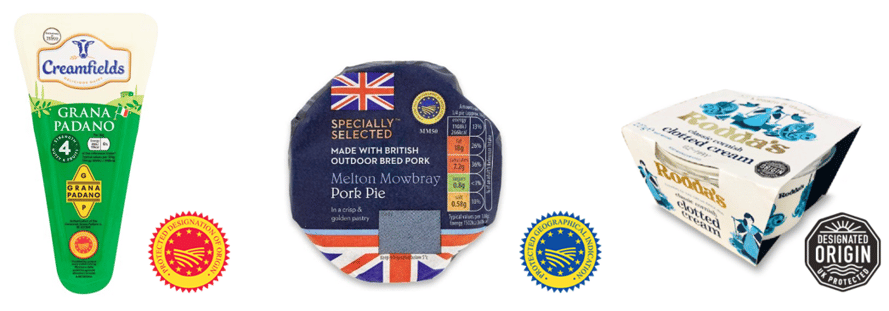A geographical indication (GI) is a form of intellectually property right that protects food, drink and agricultural products originating from a specific region, often with particular methods of production. As a result, they possess certain characteristics and a reputation. Some well-known examples include Scotch whisky, Cornish pasty and Stilton blue cheese.
Unlike trade marks, GIs are not owned by individuals or businesses. Any producer can make and sell a product under a registered GI if they follow the specifications and are verified to do so.
When the UK left the EU, a new system was set up to protect GI rights in the UK.
The GI systems
Until 31 December 2020, EU law provided protection for GIs in the UK under the following forms and logos:

- Protected Designation of Origin (PDO) – these products have the strongest link to the place they were made (for example, Kalamata Olive Oil)
- Protected Geographical Indication (PGI) – these products emphasise the relationship between the geographic region and the name of the product (for example, Kentish Ale)
- Geographical Indications of spirit drinks and aromatised wines (GI) – these products originate from a country, region or locality where the product’s particular quality, reputation or other characteristic is essentially attributable to its geographical origin (for example, Irish Whiskey)
- Traditional Speciality Guaranteed (TSG) – these products highlight the more conventional aspects of a product (such as the way it is made or its composition), without linking it to a specific geographical area (for example, Watercress)
Following Brexit, the UK government set up its own GI schemes and new GI logos were launched:
 Which logo to use
Which logo to use
The rules regarding use of a GI logo on a product are specific to each UK GI scheme. It may be necessary to add the corresponding EU logo to a product depending on where it is sold.
For protected food name products (which includes food, beer, cider, perry and agricultural products) from Great Britain registered before 1 January 2021:
- you must add the relevant UK logo to a product sold in Great Britain by 1 January 2024
- you can choose to add the relevant UK logo to a product sold in Northern Ireland or in the rest of the world (unless it conflicts with local regulations)
- you can choose to add the EU logo on a UK protected food name registered under the EU scheme to a product sold in the UK and the rest of the world.
For protected food name products from Great Britain registered after 1 January 2021:
- you must add the relevant UK GI logo as soon as it goes on sale in GB as a GI product
- you can choose to add the relevant UK logo to a product sold in Northern Ireland or in the rest of the world (unless it conflicts with local regulations)
- you can only use the EU GI logo if the product is registered under the EU GI scheme.
Registered wine products of UK origin may carry the relevant UK GI logo on the product or its label. If you do use it, the logo must be in the same field of vision as the product’s registered GI name. The relevant GI designation (‘protected designation of origin’ / ‘protected geographical indication’) must be displayed in full on the packaging.
Registered spirits of UK origin may carry the PGI logo. Again, if you do use it, the logo must be in the same field of vision as the product’s registered GI name. The words ‘protected geographical indication’ must be displayed in full on the packaging.
Some examples of the EU and UK logos applied to products are shown below:

In some cases, it is possible to use the UK and the EU logo (if your product is registered under both schemes, for example). You must check local regulations before displaying both logos on your products. To avoid clutter, you may choose to use just one logo in situations when the use of both logos is optional.
Use of the UK GI logos
It goes without saying that you can only use a logo on a product if the name has GI protection and you must use the logo associated with the designation awarded to the registered GI name.
You must not alter, crop or distort the logo, change its colour, change its shade, add to or remove any part of the logo.
The rules regarding the UK GI scheme and use of the logos can be found here and here. Further information about the use of the EU logos can be found on the European Commission’s website.
If you need more advice or have any questions, please get in touch with your usual Mewburn contact or email mail@mewburn.com.
Claire is a senior associate in our trade marks team. She advises clients on the availability, protection, use and enforcement of trade marks and is experienced in the management of worldwide portfolios. Claire has worked with clients in a diverse range of fields, including sports and fitness, newspaper publishing and real estate. Claire has also gained first-hand knowledge of in-house IP work, having begun her career as a trade mark administrator at a large entertainment company. She also undertook a five-month secondment at a multinational alcoholic beverages company in 2015.
Email: claire.evans@mewburn.com

-Dec-29-2025-09-11-25-2361-AM.png)
